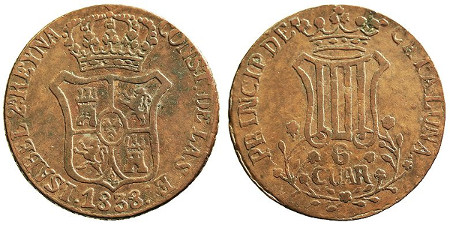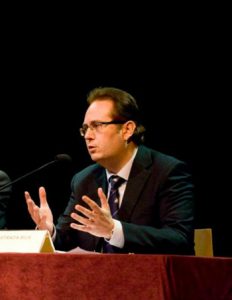
Coin minted in Barcelona in 1838, during the reign of Isabel II. Made in copper
Albert Estrada-Rius, corresponding academician of the Royal European Academy of Doctors-Barcelona 1914 (RAED), will present on October 10, at 7 pm, at the Royal Academy of Sciences and Arts of Barcelona the works “La falsificació de moneda a la Catalunya del segle XIX” (Counterfeiting Currency in Catalonia of the XIXth century) and “Les dues cares de la moneda. Fabricació versus falsificació a Catalunya” (The two sides of the coin: Manufacturing versus counterfeiting in Catalonia), which focus on the historical period from the reopening of the Seca or Mint House in Barcelona in 1808 , to the scandal of the Sevillians coins of 1908.
Both books have been coordinated by Estrada-Rius, chief curator of the Numismatic Cabinet of Catalonia, and edited in co-edition by the Pompeu Fabra University and the National Museum of Art of Catalonia, within the collection of “History of Law Studies”. These collective works include, respectively, the results of the study on “Counterfeiting of money in Catalonia of the 19th century”, held in December 2012, and the international symposium “The two sides of the coin.

Dr. Albert Estrada Rius
Manufacturing versus counterfeiting in Catalonia”, which took place in December 2015 under the auspices of the former Fábrica de Medallas Ausió, which exercises a generous patronage over the activities organized by the Numismatic Office of Catalonia.
These scientific meetings and the two publications have a clear thematic continuity and emphasize a theme and a period to which historiography had paid little attention: Catalonia of the nineteenth century, immersed in the Industrial Revolution and a political awakening that also had implications in monetary matters, such as the closure and reopening of its Mint. The manufacture of currency in the Seca, which will finally be closed in 1881, is a reflection and testimony of these processes. At the same time, the phenomenon of monetary counterfeiting in Barcelona is also huge and novel stuff.
These subjects have focused on specialists who have worked on such different aspects as the role of criminal legislation or the judicial and police prosecution of counterfeiters, diplomatic interventions by France to avoid the falsification of their numerary in the city or treatment of the phenomenon in the written press and in his humorous drawings, the study of several counterfeit workshops located thanks to the archeology or some of the series of false coins that are conserved in the Numismatic Cabinet of Catalonia.




